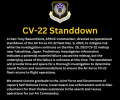Spekkio
He bowls overhand.
So rotary in general is 3x more dangerous than fixed wing... and we should get mad at the media for highlighting this about ospreys but excluding other rotary platforms.... and somehow this makes ospreys more safer because no one is advertising other rotary class A mishaps...The media makes it seem that Ospreys are plagued with all sorts of issues and falling out of the sky on a regular basis, I am not surprised as that results in clicks, which leads to more advertising dollars.
This is Donald Trump logic


